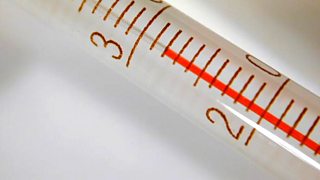Seven wonders of the temperature scale: Helen Czerski answers your questions on hot, cold and everything in between
Everything in the world around us exists somewhere on a vast scale from cold to hot. Whether living or lifeless, solid or liquid, visible or invisible – everything has a temperature. Across three programmes, physicist Dr Helen Czerski takes us on a spectacular journey to the extremes of the temperature scale. She explores what temperature really is, and how it can change the state of matter, forge new substances from old and start reactions that can create or destroy entire worlds. Temperature is the architect that has shaped our planet, and the entire Universe.

Dr Helen Czerski’s doctoral study was in experimental explosives physics, after which she moved into oceanography and the science of ocean bubbles. Across these three programmes, she recreates some of the key scientific breakthroughs of the past three centuries and conducts demonstrations of her own to reveal surprising properties of different matter at different temperatures – each uncovering something fundamental about ourselves, our planet or the Universe.
Helen invited members of the public to send her Tweets telling her what they most wanted to know about temperature.
Here, she answers a few of the most popular questions:
Why can’t I have a thermal imaging camera on my phone?
Thermal cameras offer a really striking perspective on the world, and many people would love to have access to a thermal imager on their phones. It’s not impossible, but it’ll be a while before these can be built into something as small as a phone, and even longer before it’s a cheap thing to do. There are some thermal camera attachments for phones available already, but the pictures are still relatively low quality.

In principle, the thermal information is always there. Everything that has a temperature is radiating energy away in the form of light, and at the temperatures in our everyday world, that light is mostly in the mid-infrared.
Visible light – the colours of the rainbow - has wavelengths of 0.4-0.7 micrometres (one micrometer is one thousandth of a millimeter). But the infrared wavelengths that you need for thermal imaging are much longer - around 9-14 micrometers.
If you can collect and focus enough of this infrared light, you can calculate what the thermal world looks like.
The chief difficulty is building small lenses and sensors that will work at those longer wavelengths. Glass reflects infrared, so you need to make your lenses from other materials like germanium or zinc selenide, for example, and make sure that they bend the light enough to focus without blurring the different wavelengths.
Most camera phones have a sensor for visible light that’s based on CMOS technology, but these won’t detect infrared. So you need to use a completely different type of sensor, one that’s currently harder to build. It’s also difficult to make these sensors sensitive enough – the tiny lens on your phone only lets in a tiny amount of light and the smaller the sensor, the more light it needs. All of these are technological challenges that could theoretically be overcome, but we’re not there yet.
We’ve spent 40 years perfecting digital photography, but we’re only getting started on the thermal equivalent. But I can’t wait for thermal cameras to become more easily available. I very rarely get excited by new phone technology these days, but I would certainly perk my ears up if a good quality thermal camera was on offer!
Hot water freezes more quickly than cold water. Is this true for any other liquids?
It is true that hot water freezes more quickly than cold water in some circumstances and it’s known as the Mpemba effect. Possibly the most dramatic demonstration is throwing hot coffee in the air when it’s -15°C or below – it freezes in the air and drifts away as mist. But if you do the same with cold water, it stays liquid and splashes back down to earth.

It’s never really been explained to everyone’s satisfaction, and there are lots of hypotheses about what’s going on. Some scientists even dispute that it happens at all, although there’s plenty of credible evidence that this is a real effect.
Water is a very unusual molecule, and we still don’t fully understand all the subtleties of how water molecules interact with each other. That’s true even though the water molecule sounds very simple - it’s just one oxygen and two hydrogen atoms combined in a friendly Mickey-Mouse shape. But it’s unusual because there is a very uneven distribution of electric charge along the molecule, and that means that the forces between molecules can get quite complicated.
In my opinion, the most credible explanations of the Mpemba effect to date depend on the physics of these complexities, and so a full explanation will probably have to wait until we understand water itself better. There don’t seem to be any observations of the Mpemba effect other liquids, and we already know that this molecule is highly unusual, so it seems likely that this beautifully counterintuitive bit of physics only happens in water.
More reading: https://www.sciencealert.com/the-centuries-old-claim-that-hot-water-freezes-faster-than-cold-just-got-even-weirder
In hot weather, is it better to wear black or white?
The reason this question is worth asking is that there’s a link between the way an object takes in and gives out light energy. When the sun warms us up, our skin is absorbing sunlight and heating up because of that absorption.

We can see some of that light: the colours of the rainbow. Most of the rest is infrared light which is invisible to our eyes, although we can feel it when we hold our hands up to a fire. But every object is also radiating away heat energy, all the time. The heat given off from each of us is all in the infrared so we can feel it but not see it.
Here’s the link: if an object is reflective, it will also radiate away its own heat very slowly. But if an object mostly absorbs the light that lands on it, it will be able to radiate away its own heat very quickly.
So black objects tend to be good at absorbing the light that falls on them (making them heat up), but they will also cool themselves down quickly by radiating that energy away.
A white object will stay cool in the sun for a while because it will reflect most light away. But when it does eventually heat up, it will stay warm for longer because it can’t lose that heat.
Here’s the choice, then. Do you wear black clothes that will absorb most of the sunlight but will also radiate that heat away very quickly? Or do you wear white clothes that will bounce the sun’s energy away, but won't radiate away the heat that you’re generating for yourself on the inside?
It’s been quite a controversial topic over the years, although there aren’t many in-depth studies. The answer seems to depend on the exact situation. A famous paper in 1980 (https://www.nature.com/articles/283373a0) noted that the Bedouin wear black robes in astonishingly hot desert conditions, and found that the advantages and disadvantages pretty much cancelled out.
But other factors matter more than colour – loose clothing can be very helpful for heat loss, because the air that flows between you and the clothes will cool you down. And if it’s a windy day, the wind will help cool you too.
In short, wear whatever works for you in a given situation. But the colour probably doesn’t matter too much.
Find out more:
Will a hot drink in hot weather really cool you down?
The short answer is yes, and it will even cool you down more than a cold drink in the right circumstances. There’s a trade-off between the heat you gain by drinking something hot, and the heat that you could potentially lose because you’ve got a bit more water to sweat away.

Sweating is extremely effective at helping you lose heat because when water evaporates from your skin into the air, it takes a colossal amount of heat energy with it.
On a simple comparison, it looks as though a hot drink is always better than nothing. Let’s compare 100 ml of water at 10°C or 50°C. You take on 16.7 kJ more heat energy with the hot drink, but if you sweat all that water away, you could potentially lose more than ten times that: 226 kJ. The key word here is “if”.
On a humid day or when you’re wearing many layers of clothes, your sweat probably isn’t evaporating so being able to sweat more won’t help. And your body probably won't use all of that water for sweat anyway. But on balance, a hot drink is likely to cool you down more than no drink at all.
But what if you have the choice between a hot drink and a cold drink? The interesting thing is that drinking a hot fluid may encourage your body to sweat more, and so you lose more heat overall than if you’d had something cold. The temperature receptors inside your body register the extra heat, and send out a signal to your skin to increase sweating.
The same caveats apply – if it’s humid and you’re dripping with sweat to start with, your sweat isn’t evaporating, so more sweat won’t help. In that situation, a cold drink will at least cool your insides a bit, so choose something that’s been in the fridge. But if it’s a dry day, the best option might really be a hot drink.
Find out more: https://www.smithsonianmag.com/science-nature/a-hot-drink-on-a-hot-day-can-cool-you-down-1338875/
Although note that this 2012 study does have a bias - it was done on young (22 years old) males, and so the broad conclusion may not represent the entire population.
Is there a maximum possible temperature?
The hottest known place in the universe was discovered in 2009 by a Japanese spacecraft called SUZAKU, which was looking at a distant galaxy cluster. They found a region of gas inside that cluster at 300 million degrees Celsius, a staggeringly high temperature. But that’s still a thermal tiddler compared with the early universe.

It’s thought that just after the Big Bang, our universe spent a brief moment at 10³² degrees Celsius, (1 followed by 32 zeros). This has been labelled the Planck temperature, and it also defines the edge of our knowledge about how hot things can get.
The problem is that beyond that point, we know our current theories won’t work. Until we have a proper theory of quantum gravity, we won’t know whether the Planck temperature is “Absolute Hot”, or whether there’s still more thermal physics to explore beyond that point.
More here: http://www.isas.ac.jp/e/forefront/2009/oota/
Why do heat waves distort vision?
It’s a familiar sight on a hot day – shimmering heat haze over a tarmac road, or above a black car bonnet. The scene behind is still there, visible through the haze, but it’s flickering and blurred.

Heat haze is a reminder that the atmosphere doesn’t leave light untouched, even though we assume that air is invisible. Our fragile atmosphere can bend the path of light, ever so slightly. The amount of bending depends on how spread out the air molecules are: their density.The heated air rising from the tarmac is less dense, but the edges of the hot plume are mixing with and shunting around the cooler (denser) surrounding air, so this region has a mishmash of air at lots of different densities.
As light from behind travels through this complex air flow, the tiny diversions caused by the density changes are different from moment to moment and from place to place. So our view of what’s behind shimmers, and experience tells us that it’s because the air is hot. Heat haze always makes me appreciate how transparent our atmosphere normally is – we can look at something miles away and still see a perfectly sharp image, almost as if the atmosphere wasn’t there.
But a little bit of heating reminds us that even something as nebulous as air can leave its signature on the light we see.
Why does 25°C air feel warm, but 25°C water feels cold?
If you step into an outside pool or pond on the afternoon of a hot day, it’s quite likely that the air and water will have similar temperatures. But the air just feels hot and stuffy, while the water feels cool and refreshing.

If air and water are at 25°C, they’re both cooler than you (37°C) so heat will flow from you to both the air and the water because heat energy always flows from the hotter thing to the colder one. We learn at school that there are three ways to move heat energy around: conduction, convection and radiation.
The heat loss here comes mostly from conduction – air or water that touches your skin directly will take some heat energy away. Water feels colder because it’s removing heat from your skin more quickly, and there are two reasons for that.
The first is that there are just more water molecules touching your skin, because the molecules are closer together in a liquid. The second is that it takes four times more energy to heat up a kilogram of water by 1°C than to heat up a kilogram of air by 1°C. This means that you can lose more heat energy to water without warming it up very much, and that keeps the heat transfer rate high.
So even though you’re losing heat to the air, it’s not happening very quickly. If you’re generating heat faster than you’re losing it, you’ll warm up. That’s why the air feels warm, but it’s not really the air that’s warm, it’s just you!
-
![]()
From Ice to Fire: The Incredible Science of Temperature
Three-part series in which Helen Czerski explores the science of temperature.

